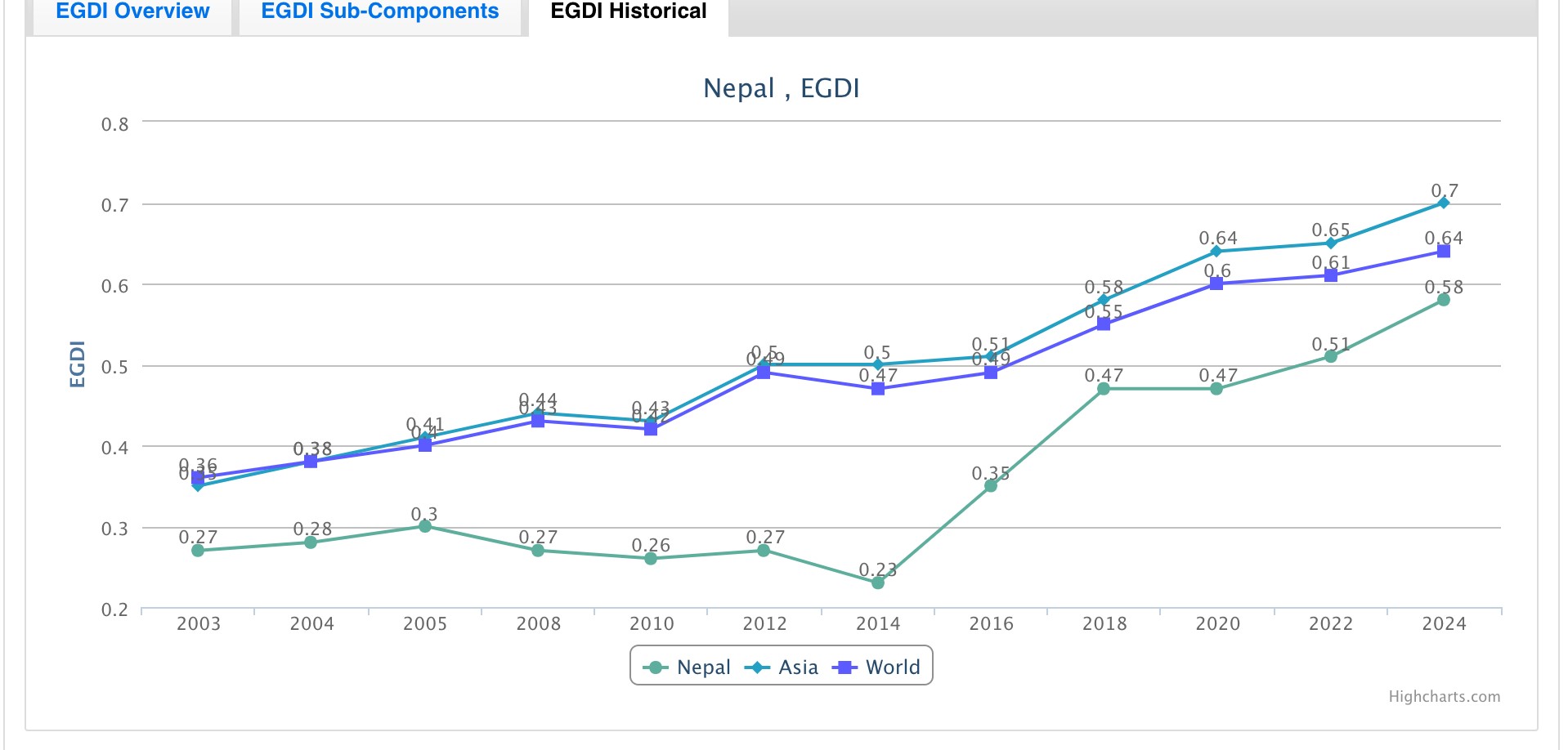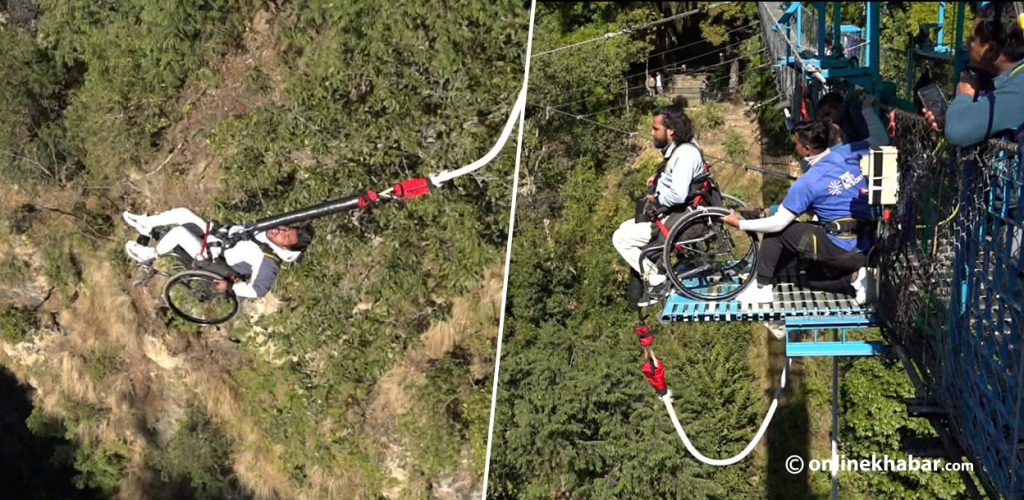
E-governance, also known as electronic governance, involves the use of information and communication technologies (ICTs) to make the government service delivery more accessible and efficient. In a rapidly expanding digital world, the integration of digital technologies is becoming central in providing citizens with a more direct way to access services, and participate in the decision-making processes.
It is a means to foster greater transparency and accountability within government systems, via making services, and operations more accessible and open to the public.
In recent years, Nepal has made significant efforts in e-governance, be it through digitising service delivery, introducing new policies and guidelines, and setting up relevant institutions. Nepal’s political leadership has also repeatedly acknowledged the need for digital transformation via integrating e-governance and paperless technologies.
Nepal’s budget of Rs 1.96 trillion for the fiscal year 2025/26 also emphasises promoting digital infrastructure as a core focus – with Rs 7.4 billion specifically allocated to build and expand digital infrastructures and developing supporting ecosystems. However, accomplishing a robust e-governance mechanism requires a coordinated effort that tackles the pre-existing systemic and structural challenges for Nepal.
E-governance landscape in Nepal
Nepal’s consolidated efforts in e-governance began in 2022 when the government formed a dedicated E-Governance Board within the Office of the Prime Minister. The Board has been assigned to developing policies, frameworks and digital infrastructure to streamline government operations, digitise public service delivery, ensure efficient data flow between different government bodies, and strengthen cyber security.
It has also published a draft “E-Governance Blueprint”, which provides a clearer vision of the government’s approach to e-governance. The draft BluePrint is structured around seven key pillars including legal and regulatory frameworks, digital literacy and skills development, research and development, and strengthening regional and international cooperation. It also proposes establishing several institutions at federal and sub-national level to strengthen the digital infrastructure.
The preparations however, had begun long-before, with the introduction of the E-Governance Master Plan in 2010, developed with the support of KOICA. This plan had outlined several initiatives that were later solidified including introducing online applications for government services, Nagarik App and National Identity Card.

TheNagarik App first introduced in 2018 serves as a one-stop digital platform providing citizens access to various government services, including tax registration, social security, and document verification. With over 800,000 users, the app continues to update its services, improving usability and efficiency, and simplifying access to government services with just a few taps. The National Identity Card has also been introduced as a unified identity system to enable access to various services.
The government had also launched the Digital Nepal Framework in 2019, showing a roadmap as to how digital efforts can address social and economic growth across Nepal. The framework outlines 80 initiatives spread across eight sectors for the government to prioritise digital foundation, agriculture, health, education, energy, tourism, finance and urban infrastructure.
In recent years, this framework has received a large amount of funding from both the Ministry of Communications and Information Technology (MoCIT) and the World Bank. However, limited inter-agency coordination, weak ownership, insufficient technical infrastructure and financial constraints hindered its effective implementation. Building on this, Digital Nepal Framework 2.0 has also recently been drafted, which suggests working on key digital enablers, incorporating newer technologies, strategic stakeholder collaboration and more.
Challenges to e-governance

The frequent instances of cyber attacks on the critical government services; more recently on the passport department have exposed glaring vulnerabilities in Nepal’s digital infrastructure. Such incidents, reportedly hiked 380% annually, underline the urgency of strengthening security measures across all e-governance initiatives.
The risk of large-scale data breaches is ever-present. A National Cyber Security Center has been established to develop policies and strategies for improving cybersecurity, however, the center still struggles with operational challenges. Nepal should look to nations such as Estonia which has already established itself as a global leader in e-governance.
It has a national cybersecurity strategy and encrypted digital IDs for citizens. Nepal should also establish a more transparent data protection policy and gain increased trust from its users. Once a secure framework for the growth of e-governance has been established, we can then begin to focus on the streamlining of government services.
Similarly, digital-divide and uneven access to technology and information also creates digital disparity across Nepal. The access to internet and digital technologies have been limited due to geography and socio-economic conditions.
In order for Nepal to pursue rapid development in e-governance, the government must first seek to establish wider and more consistent access to ICTs so that more people have an even level of digital access.
The 16th Five Year plan has set the goal of 90% of households to have internet access by 2029. The National Census in 2021 showed the access to be only at 37.8%. Addressing the Digital Divide in Nepal is indeed no small task, however, by looking at examples of civic engagement in E-governance across the globe, we can draw on inspiration to bring greater participation in digital governance.
In India, the government used mobile-based services like UMANG, a multi-functional app that provides access to over 1000 services from both central and state governments and community-based digital literacy like Common Community Centers (CSC) programs to make digital governance accessible to rural populations.
The gap also lies in the lack of data interoperability, which forces citizens to repeatedly re-enter their data each time they access new services. Also, each government body – particularly ministries – have their own separate Management Information Systems (MIS), and the absence of data exchange platforms prevents coordination between these agencies.
As a result, the service seekers have to present a whole bunch of paperwork/ information whenever they require service from any ministry, leading to bureaucratic delays. To address this, the government must establish a one-step data entry system and enable data sharing across horizontal and vertical levels. This priority is already highlighted in the E-Governance Blueprint and, if effectively implemented, could significantly ease service delivery for citizens.
Moreover, there is a fundamental gap in understanding the ICT domain within the government itself. The responsibility for information management is often delegated to computer operators, who may lack the expertise to handle complex data or the contextual knowledge required for effective management.
There is a need to recruit highly skilled IT professionals in government offices and as service providers. Employing qualified experts would not only enhance the efficiency of digital systems but also foster greater public trust, as citizens would have more confidence that their information is secure and private. For this, the government could also leverage the capacities of the private sector, which are more competent compared to the government in ICT and data handling.
It is also important to ensure policy revision and alignment to enable the execution of e-governance services across all levels in Nepal. Lately, various overlapping strategies on digitising Nepal are being developed including Digital Nepal Framework, the E-Governance Blueprint and many other policies and guidelines. However, there is a lack of alignment and mechanism to ensure how one policy reinforces or builds on another policy.
Also, with many guidelines being introduced, while the federal government may have the resources and capacity to execute e-governance services, local and provincial governments often lack the knowledge, resources and capacity to implement them effectively. The capacity building of local and provincial governments to adopt digital systems, manage information and digitise their services are equally important. The implementation will remain fragmented without coordinated mandates and shared responsibilities across all levels.
Conclusion
Lastly, Nepal’s journey towards effective e-governance is still evolving and requires a holistic approach. It includes investing in infrastructures that enhance citizens’ access to fostering a stronger institutional coordination, long-term planning and policy alignment.
Here are some actionable recommendations that Nepal could adopt:
- Assess the existing platforms to check their effectiveness and avoid duplication. It is equally important to improve the usability and efficiency of the existing platforms as much as to introduce new services or incentives.
- Build a central e-governance strategy which outlines the vision of Nepal’s e-governance aspirations along with an action plan for implementation. It should also clearly define the mandates and implementation responsibilities of provincial and local governments.
- Invest in digital access infrastructures such as internet connectivity, community centers and for improved access to digital devices. The efforts should also be paired with digital literacy programs, especially in rural areas.
- Partner with private sectors including tech firms and financial institutions to build effective systems or deliver public services, especially in sectors where private sectors maintain reliable digital systems and show scope of profit.
- Enhance cybersecurity frameworks through operationalising National Cyber Security Center more effectively, developing a data protection law, and creating public awareness on digital rights and safety.
- Hire specialised IT professionals where necessary and regularly conduct capacity building training for government officials in ICT tools and data governance.
It is only through inclusive planning, strategic investments, strong political willingness, citizen empowerment, and coordinated implementation mechanism that Nepal can maximise its e-governance potential.





















